Bitcoin mining has evolved from a hobby for tech enthusiasts into a competitive landscape dominated by specialized hardware. At the heart of this transformation are Antminers, powerful devices engineered specifically for mining Bitcoin. These machines perform complex mathematical calculations essential for securing the blockchain, a process that rewards miners with newly minted bitcoins and transaction fees. As the demand for Bitcoin grows, so does the interest in mining technology, with Antminers leading the charge as one of the most sought-after pieces of equipment in the cryptocurrency mining industry.
However, the high cost of new Antminers and their often limited availability have led many prospective miners to consider the secondary market. Buying second-hand Antminers presents a cost-effective solution for those looking to enter the mining scene without the hefty investment required for new hardware. This approach not only makes mining more accessible but also offers a quicker return on investment, making it an attractive option for both novice and experienced miners alike.
Despite the apparent benefits, purchasing used mining hardware comes with its own set of risks and considerations. From the potential for decreased performance due to wear and tear, to the absence of warranties and support from manufacturers, buyers must navigate a minefield of factors that could impact the success of their mining endeavors. This article aims to explore these risks and considerations in depth, providing prospective buyers with the knowledge needed to make informed decisions when venturing into the market for second-hand Antminers. Through a comprehensive examination of the advantages and pitfalls of buying used mining hardware, readers will gain insights into how to best approach this cost-effective solution while minimizing potential downsides.
The Appeal of Second-Hand Antminers
The cryptocurrency mining landscape is both dynamic and competitive, with efficiency and cost-effectiveness being paramount for miners. In this context, second-hand Antminers emerge as a compelling option, offering a blend of affordability, accessibility, and performance. Here’s a closer look at the key factors contributing to the appeal of second-hand Antminers:
Cost Savings and Affordability
One of the most significant advantages of opting for second-hand Antminers is the considerable cost savings. New mining hardware can be prohibitively expensive, not only due to the high price tags but also because of the rapid pace at which mining technology evolves. By choosing second-hand units, miners can significantly reduce their initial investment. This affordability makes entering the mining space more accessible, especially for individuals and small-scale operations that may not have the capital to invest in brand-new equipment. The lower cost also opens up the possibility of purchasing multiple units for the price of one new miner, potentially increasing the mining capacity and diversifying the risk.
Immediate Availability Compared to New Models
The demand for the latest Antminer models often outstrips supply, leading to wait times that can hinder a miner’s ability to quickly capitalize on favorable mining conditions. Second-hand Antminers, on the other hand, are readily available through various channels, including online marketplaces, forums, and dedicated cryptocurrency mining hardware resellers. This immediate availability allows miners to quickly set up or expand their operations without being hampered by the production and distribution delays commonly associated with new models. In the fast-moving world of cryptocurrency, the ability to swiftly adapt and scale operations can be a critical factor in maximizing mining profitability.
Potential for High Performance at a Lower Investment
While second-hand Antminers may not always represent the cutting edge of mining technology, many used models still offer high performance and efficiency. The ASIC (Application-Specific Integrated Circuit) technology used in Antminers is designed specifically for Bitcoin mining, ensuring that even older models perform their tasks effectively. For many cryptocurrencies, especially those with lower mining difficulty than Bitcoin, second-hand Antminers can still compete effectively, generating substantial returns on investment. By carefully selecting models known for their durability and longevity, miners can secure hardware capable of sustaining profitable mining operations, all while keeping initial costs to a minimum.
In summary, the appeal of second-hand Antminers lies in their ability to offer a cost-effective entry point into cryptocurrency mining. By balancing the advantages of cost savings, immediate availability, and potential for high performance, miners can strategically navigate the risks associated with used mining hardware. This approach not only democratizes access to Bitcoin mining but also enables savvy miners to optimize their operations for maximum efficiency and profitability.
Key Advantages of Second-Hand Antminers
The market for second-hand Antminers offers a unique set of opportunities for individuals and businesses looking to venture into the realm of cryptocurrency mining. Beyond the initial appeal of cost savings and availability, there are several key advantages that make purchasing used Antminers a strategic choice for many. Here’s a detailed analysis of the primary benefits:
Lower Upfront Costs
The most immediate benefit of opting for second-hand Antminers is the significantly lower upfront cost. New mining hardware can be a substantial financial investment, often running into thousands of dollars per unit. Second-hand models, however, are available at a fraction of the price, providing an economical alternative for those looking to minimize initial expenditures. This reduced cost barrier enables miners to allocate funds more flexibly, whether by investing in additional hardware to scale their operations or by conserving capital for other aspects of their mining endeavors, such as energy costs or infrastructure upgrades.
Access to Models No Longer in Production
Cryptocurrency mining technology evolves rapidly, with manufacturers frequently releasing new models to keep pace with the increasing complexity of mining algorithms. As a result, certain models that may still be efficient and viable for mining are no longer produced. Second-hand markets offer access to these discontinued models, allowing miners to utilize hardware that, despite being older, can still be highly effective for mining specific cryptocurrencies. This access not only diversifies the options available to miners but also opens up opportunities to experiment with different hardware configurations and mining strategies.
Short-term ROI Potential
For many miners, the ultimate goal is to achieve a favorable return on investment (ROI) in the shortest time possible. Second-hand Antminers, with their lower purchase price, can often reach profitability more quickly than their brand-new counterparts. The reduced initial outlay means that the revenue generated from mining need not be as high to cover the cost of the hardware, thereby potentially shortening the time to achieve ROI. This aspect is particularly appealing in the volatile cryptocurrency market, where the ability to adapt and pivot operations efficiently can significantly impact overall profitability.
Understanding the Risks
While the allure of cost savings and immediate availability makes second-hand Antminers an attractive option for many, it’s crucial to navigate the venture with a clear understanding of the potential risks involved. Buying used mining hardware can come with several challenges that could impact the efficiency, profitability, and overall success of your mining operation. Here’s an overview of common risks associated with purchasing used Antminers:
Reliability and Lifespan Concerns
One of the primary concerns when buying second-hand Antminers is the uncertainty regarding their reliability and remaining operational lifespan. Mining hardware is often run continuously under considerable load, which can lead to wear and tear on components over time. This continuous operation can reduce the efficiency of the hardware and increase the likelihood of failure. Without a comprehensive history of the device’s usage and maintenance, it’s challenging to predict how long a used Antminer will operate before requiring significant repairs or replacement.
Lack of Warranty and Manufacturer Support
New Antminers typically come with a manufacturer’s warranty, offering protection against defects and malfunctions. However, second-hand units often lack this warranty coverage, leaving buyers with little recourse in the event of hardware failure. Additionally, manufacturer support, including access to firmware updates and technical assistance, may not be readily available for second-hand purchases. This lack of support can complicate troubleshooting efforts and potentially lead to prolonged downtime.
Potential for Hidden Damage or Tampering
Used Antminers may have hidden damage or may have been tampered with by previous owners. For instance, attempts to overclock the device to boost performance can overstress components and lead to premature failure. Similarly, physical damage from poor handling or suboptimal mining environments (like excessive heat or humidity) may not be immediately apparent but can significantly impact the miner’s performance and longevity. Buyers must be diligent in inspecting hardware and verifying its condition to mitigate these risks.
Obsolescence and Compatibility Issues with Mining Pools
The rapid pace of technological advancement in cryptocurrency mining can quickly render older hardware models obsolete. While a second-hand Antminer may offer suitable performance at the time of purchase, future increases in network difficulty or changes in mining algorithms could diminish its effectiveness. Additionally, compatibility issues with mining pools—platforms that combine the computational power of multiple miners to increase the chances of earning mining rewards—can arise, as some pools may not support older or less efficient hardware. This obsolescence and lack of compatibility can limit a miner’s ability to adapt to the evolving mining landscape and maintain profitability.
Navigating these risks requires thorough research, careful inspection, and sometimes a bit of technical expertise. By understanding the potential pitfalls of buying used Antminers, prospective buyers can make more informed decisions, weigh the cost-benefit ratio more accurately, and develop strategies to mitigate these risks, ensuring a more secure and potentially profitable mining operation.
Evaluating Seller Reputation
When venturing into the market for second-hand Antminers, the reputation of the seller or the platform becomes a critical factor in ensuring a satisfactory purchase. The variability in the condition of used mining hardware, combined with the absence of a standard warranty, makes it essential to conduct due diligence on the seller. Here’s how to approach this crucial step:
Importance of Researching the Seller or Platform
The legitimacy and reliability of the seller or platform can significantly impact the quality and authenticity of the second-hand Antminer you intend to purchase. A reputable seller not only guarantees that the hardware is as described but also provides a level of post-sale support that can be invaluable, especially in instances where the unit may require troubleshooting or repairs. Researching the seller helps mitigate risks associated with fraudulent listings, misrepresented item conditions, and potential scams.
Red Flags to Watch Out for in Seller Profiles and Listings
Several red flags may indicate a seller might not be trustworthy:
- Lack of Detailed Information: Listings that lack detailed descriptions, specifications, or clear images of the Antminer may indicate a lack of transparency.
- Too Good to Be True Pricing: While second-hand units are cheaper, prices significantly below market value can be a sign of potential scams or faulty equipment.
- Poor Communication: Sellers unwilling to answer questions or provide additional information about the Antminer’s condition or history may not be reliable.
- Negative Reviews: Consistently poor feedback or complaints about the seller across multiple platforms should raise concerns.
- New or Anonymous Profiles: Sellers with newly created profiles or those lacking verifiable information may warrant caution.
Tips for Verifying Authenticity and Condition of the Antminer
To ensure you’re making a wise investment, consider the following tips:
- Request Detailed Photos and Videos: Ask for current, high-resolution images and videos showing the Antminer operating, focusing on serial numbers and any potential areas of damage.
- Inquire About the Mining History: Understanding how the unit was used, including the mining environment and whether it was overclocked, can provide insights into its condition and longevity.
- Seek Proof of Purchase: Original invoices or proof of purchase can help verify the Antminer’s authenticity and age.
Utilizing Forums, Reviews, and Community Feedback
The cryptocurrency mining community is a valuable resource for prospective buyers. Engaging with forums and mining groups can provide insights into reputable sellers and platforms. Here’s how to leverage community knowledge:
- Read Seller Reviews: Look for reviews on independent platforms, social media, and mining forums. Pay attention to both positive and negative feedback to gauge the seller’s reliability.
- Participate in Discussions: Mining forums and social media groups are excellent places to ask about specific sellers or platforms. Community members can share their experiences and offer recommendations.
- Check for Endorsements: Some sellers or platforms may be well-regarded within the community for their integrity and quality of service. Look for these endorsements as a sign of trustworthiness.
By thoroughly evaluating the reputation of sellers and utilizing the collective knowledge of the mining community, buyers can significantly reduce the risks associated with purchasing second-hand Antminers. This careful approach ensures that the investment into used mining hardware is both secure and potentially rewarding.
Technical Inspection and Verification
Purchasing a second-hand Antminer requires a thorough technical inspection to ensure the unit is in good working condition and capable of performing efficiently. This step-by-step guide outlines the essential checks and verifications you should perform or seek professional assistance with before finalizing your purchase.
Step 1: Physical Condition Checks
- Exterior Inspection: Begin with a visual inspection of the Antminer’s exterior. Look for signs of physical damage, such as dents, rust, or excessive dust accumulation, which could indicate poor maintenance or exposure to harsh conditions.
- Component Check: Verify that all components are intact and securely attached. This includes the fans, heat sinks, power supply units, and any external connectors. Loose or missing parts can affect the miner’s performance and longevity.
- Cooling System: The cooling system is crucial for maintaining optimal operating temperatures. Ensure the fans are clean and functioning correctly. Listen for any unusual noises that might indicate bearing issues or obstructions.
Step 2: Performance Benchmarking
- Hash Rate Verification: Connect the Antminer to your mining setup and monitor its hash rate. Compare the observed performance to the manufacturer’s specifications for that model. A significant discrepancy could signal underlying issues.
- Stability Test: Run the Antminer for an extended period (at least 24 hours) to test its stability under continuous operation. Monitor for any unexpected shutdowns, overheating, or performance drops.
- Energy Efficiency: Measure the power consumption of the unit using a reliable power meter. Compare this data against the expected energy efficiency to ensure the miner is not drawing excessive power, which could erode profitability.
Step 3: Software and Firmware Integrity
- Firmware Version: Check the firmware version installed on the Antminer. Outdated firmware can lead to security vulnerabilities and reduced efficiency. Verify the availability of updates from the manufacturer’s website.
- Configuration Settings: Review the miner’s configuration settings, including the mining pool details, to ensure they are correctly set up. Incorrect settings can prevent the miner from operating correctly.
- Malware Scan: Conduct a malware scan if possible, especially if the miner’s firmware allows for such checks. Previous owners could have installed malicious software to divert mining rewards.
Step 4: Consulting with Experts or Using Professional Services for Inspection
- Expert Consultation: If you’re not confident in your ability to conduct a thorough inspection, consider consulting with an expert in cryptocurrency mining hardware. They can provide valuable insights and identify potential issues that may not be apparent to the untrained eye.
- Professional Inspection Services: Some companies specialize in inspecting and verifying the condition of used mining equipment. Utilizing these services can provide peace of mind, especially for higher-value purchases. They can perform detailed checks, including component-level inspections, to ensure the Antminer meets your expectations.
- Seller Transparency: Engage with the seller about the possibility of having the unit inspected by a third party before purchase. A reputable seller should be open to this request, understanding that it can build trust and facilitate a smooth transaction.
By following these steps for technical inspection and verification, you can significantly reduce the risks associated with purchasing a second-hand Antminer. Whether you choose to perform these checks yourself or enlist the help of professionals, the goal is to ensure that your investment in used mining hardware is sound and capable of delivering the expected mining performance.
Making an Informed Decision
Purchasing a second-hand Antminer requires a thorough technical inspection to ensure the unit is in good working condition and capable of performing efficiently. This step-by-step guide outlines the essential checks and verifications you should perform or seek professional assistance with before finalizing your purchase.
Step 1: Physical Condition Checks
- Exterior Inspection: Begin with a visual inspection of the Antminer’s exterior. Look for signs of physical damage, such as dents, rust, or excessive dust accumulation, which could indicate poor maintenance or exposure to harsh conditions.
- Component Check: Verify that all components are intact and securely attached. This includes the fans, heat sinks, power supply units, and any external connectors. Loose or missing parts can affect the miner’s performance and longevity.
- Cooling System: The cooling system is crucial for maintaining optimal operating temperatures. Ensure the fans are clean and functioning correctly. Listen for any unusual noises that might indicate bearing issues or obstructions.
Step 2: Performance Benchmarking
- Hash Rate Verification: Connect the Antminer to your mining setup and monitor its hash rate. Compare the observed performance to the manufacturer’s specifications for that model. A significant discrepancy could signal underlying issues.
- Stability Test: Run the Antminer for an extended period (at least 24 hours) to test its stability under continuous operation. Monitor for any unexpected shutdowns, overheating, or performance drops.
- Energy Efficiency: Measure the power consumption of the unit using a reliable power meter. Compare this data against the expected energy efficiency to ensure the miner is not drawing excessive power, which could erode profitability.
Step 3: Software and Firmware Integrity
- Firmware Version: Check the firmware version installed on the Antminer. Outdated firmware can lead to security vulnerabilities and reduced efficiency. Verify the availability of updates from the manufacturer’s website.
- Configuration Settings: Review the miner’s configuration settings, including the mining pool details, to ensure they are correctly set up. Incorrect settings can prevent the miner from operating correctly.
- Malware Scan: Conduct a malware scan if possible, especially if the miner’s firmware allows for such checks. Previous owners could have installed malicious software to divert mining rewards.
Step 4: Consulting with Experts or Using Professional Services for Inspection
- Expert Consultation: If you’re not confident in your ability to conduct a thorough inspection, consider consulting with an expert in cryptocurrency mining hardware. They can provide valuable insights and identify potential issues that may not be apparent to the untrained eye.
- Professional Inspection Services: Some companies specialize in inspecting and verifying the condition of used mining equipment. Utilizing these services can provide peace of mind, especially for higher-value purchases. They can perform detailed checks, including component-level inspections, to ensure the Antminer meets your expectations.
- Seller Transparency: Engage with the seller about the possibility of having the unit inspected by a third party before purchase. A reputable seller should be open to this request, understanding that it can build trust and facilitate a smooth transaction.
By following these steps for technical inspection and verification, you can significantly reduce the risks associated with purchasing a second-hand Antminer. Whether you choose to perform these checks yourself or enlist the help of professionals, the goal is to ensure that your investment in used mining hardware is sound and capable of delivering the expected mining performance.
Alternatives to Buying Second-Hand Antminers
While purchasing second-hand Antminers presents a cost-effective entry into cryptocurrency mining, it’s not without its risks. For those wary of the potential pitfalls, there are several alternatives worth considering. Each option comes with its own set of advantages and considerations, catering to different preferences, risk tolerances, and investment capacities.
Renting or Cloud Mining Services
Renting Hardware: Some companies offer mining hardware for rent, allowing you to mine cryptocurrencies without owning the equipment. This option eliminates concerns about hardware maintenance, obsolescence, and upfront capital investment. However, it’s important to carefully evaluate the rental costs and terms to ensure profitability.
Cloud Mining Services: Cloud mining involves purchasing a share of the mining capacity of hardware hosted and maintained by a service provider. This model offers the advantage of participating in mining without dealing with the technical aspects of hardware setup and maintenance. However, due diligence is essential to avoid scams and to understand the contract terms, as the profitability of cloud mining contracts can vary significantly based on the price of Bitcoin and mining difficulty.
Joining Mining Pools or Cooperatives
Mining Pools: Joining a mining pool allows individual miners to combine their computational power to increase their chances of solving a block and earning rewards. While the rewards are shared among pool members, this approach can offer more consistent returns compared to solo mining, especially for those with limited mining capacity. It’s crucial to consider the pool fees and the pool’s reputation before joining.
Mining Cooperatives: Similar to mining pools, mining cooperatives are groups of miners who collaborate to share resources and rewards. Cooperatives may offer a more community-oriented approach, with members having a say in the cooperative’s decisions. This option can be appealing for those looking for a more engaged mining experience and willing to contribute beyond just computational power.
Investing in New Antminers: Cost vs. Benefit Analysis
Upfront Investment: The primary barrier to purchasing new Antminers is the higher upfront cost compared to second-hand units or alternative mining options. New models offer the latest technology, potentially higher efficiency, and manufacturer warranties, contributing to peace of mind and long-term profitability.
Long-term Profitability: Investing in new Antminers can be more profitable in the long run, thanks to their higher efficiency and longer operational lifespan. The decision to invest in new hardware should be based on a thorough cost-benefit analysis, considering the expected lifespan of the equipment, electricity costs, mining difficulty, and the potential for future growth in the value of Bitcoin.
Risk Mitigation: New Antminers come with less risk of hardware failure and obsolescence in the short to medium term. The manufacturer’s warranty and support can also provide valuable assistance in case of issues, reducing potential downtime and loss of mining revenue.
In conclusion, while buying second-hand Antminers offers a pathway to mining with a lower initial investment, alternatives like renting, cloud mining services, joining mining pools or cooperatives, and investing in new Antminers present viable options for different needs and risk profiles. Each alternative has its unique advantages and considerations, highlighting the importance of conducting thorough research and analysis to choose the best approach for your cryptocurrency mining venture.
Best Practices for Second-Hand Antminer Buyers
Purchasing a second-hand Antminer can be a strategic move for entering the cryptocurrency mining space without the hefty price tag of new equipment. However, to ensure a wise investment, buyers should adhere to a set of best practices. Here’s a comprehensive guide to navigating the process, from initial consideration to post-purchase maintenance.
Checklist for Buyers Before Making a Purchase
- Research the Model: Understand the specifications, performance benchmarks, and energy consumption of the Antminer model you’re considering. Compare it against current mining requirements to ensure it meets your needs.
- Verify Seller Reputation: Look for sellers with positive feedback, transparent transaction histories, and good communication. Platforms like eBay, Amazon, or specialized cryptocurrency forums can provide seller ratings and reviews.
- Inspect the Hardware: Request detailed photos and, if possible, a video of the Antminer running. Check for physical damage, signs of excessive wear, or modifications.
- Confirm Operational History: Inquire about the Antminer’s operational history, including its mining environment (e.g., temperature-controlled, dust-free) and whether it was overclocked.
- Discuss Warranty and Returns: Understand the terms of sale, including any warranty offered by the seller and the return policy, should the Antminer not meet the agreed-upon conditions.
Recommended Platforms and Communities for Buying Used Antminers
- Cryptocurrency Mining Forums: Communities like BitcoinTalk or Reddit’s r/BitcoinMining are excellent resources for finding reputable sellers and getting advice from experienced miners.
- Specialized Crypto Hardware Resellers: Look for online stores or platforms that specialize in cryptocurrency mining equipment. These sellers often perform their own inspections and offer limited warranties.
- Online Marketplaces: Platforms like eBay or Amazon can be good sources for second-hand Antminers, provided you thoroughly vet the seller’s reputation and review the product listing details.
Maintenance Tips to Extend the Lifespan of a Second-Hand Antminer
- Regular Cleaning: Dust and debris can significantly impact the efficiency and lifespan of your Antminer. Regularly clean the exterior and cooling fans with compressed air to maintain optimal operating conditions.
- Monitor Temperature: Ensure your mining setup is in a well-ventilated area to prevent overheating. Use software tools to monitor the temperature and adjust your mining operation as necessary to keep it within safe limits.
- Update Firmware: Keep the Antminer’s firmware up to date to benefit from the latest performance optimizations and security patches. Always download firmware updates directly from the manufacturer’s website to avoid malware.
- Power Surge Protection: Use a high-quality surge protector to safeguard your Antminer against electrical surges and spikes that could cause irreparable damage.
- Scheduled Rest Periods: Consider scheduling periodic rest times for your Antminer, especially if you notice performance degradation or overheating issues. This can help prolong the hardware’s operational life.
By following these best practices, second-hand Antminer buyers can make informed decisions, secure in their investment, and maintain their equipment for long-term mining success. The key is diligence in the purchasing process and ongoing care in the maintenance of the hardware to maximize profitability and extend the lifespan of the Antminer.
Conclusion
The journey into cryptocurrency mining is an exciting venture, offering the potential for significant returns on investment. Among the various pathways to enter this space, purchasing second-hand Antminers presents a cost-effective solution that lowers the barrier to entry for many aspiring miners. Throughout this article, we’ve explored the multifaceted aspects of buying used mining hardware, from the appealing cost savings and immediate availability of second-hand units to the critical considerations and best practices that ensure a wise investment.
Key points to remember include the importance of evaluating the seller’s reputation, conducting a thorough technical inspection of the hardware, and understanding the risks associated with second-hand equipment, such as reliability concerns and potential obsolescence. We also discussed alternative options for those hesitant to purchase used Antminers, including renting, cloud mining services, and joining mining pools, each offering different benefits and considerations.
The decision to incorporate second-hand Antminers into your cryptocurrency mining strategy should be made with careful consideration of all these factors. Conducting thorough research, leveraging community insights, and meticulously inspecting potential purchases are essential steps in making an informed decision. The appeal of lower upfront costs must be balanced against the operational risks and long-term profitability of the mining operation.
In conclusion, second-hand Antminers can indeed play a viable role in a cryptocurrency mining strategy, particularly for those looking to optimize their initial investment and navigate the complexities of the mining landscape. However, success in this endeavor requires a proactive approach to risk management, a commitment to ongoing maintenance, and a keen eye for market trends and technological advancements. By adhering to the best practices outlined in this article, miners can enhance their chances of achieving a profitable and sustainable operation, making the most of the opportunities presented by the dynamic world of cryptocurrency mining.
FAQ
What are the benefits of buying second-hand Antminers?
Buying second-hand Antminers offers cost savings, immediate availability, and the potential for high performance at a lower investment, making mining more accessible and offering a quicker return on investment.
What risks are associated with purchasing used mining hardware like Antminers?
Key risks include decreased performance due to wear and tear, absence of warranties, lack of manufacturer support, potential hidden damages or tampering, and the risk of obsolescence or compatibility issues with mining pools.
How can I evaluate the reputation of a seller when buying a second-hand Antminer?
To evaluate a seller’s reputation, research the seller or platform, look for detailed product information, assess pricing, evaluate communication, check for negative reviews, and be wary of new or anonymous profiles.
What technical inspections should be performed before buying a used Antminer?
Technical inspections should include physical condition checks, performance benchmarking, software and firmware integrity checks, and, if possible, consulting with experts or using professional inspection services.
What are some alternatives to buying second-hand Antminers?
Alternatives include renting or using cloud mining services, joining mining pools or cooperatives, and investing in new Antminers, each with distinct advantages and considerations.
What are some best practices for second-hand Antminer buyers?
Best practices include researching the Antminer model, verifying seller reputation, inspecting the hardware, confirming its operational history, discussing warranty and returns, and following maintenance tips to extend its lifespan.
How can a buyer minimize risks when purchasing second-hand Antminers?
Buyers can minimize risks by thoroughly evaluating the seller’s reputation, conducting detailed technical inspections of the hardware, engaging in the cryptocurrency mining community for insights, and considering purchasing alternatives based on risk tolerance.










